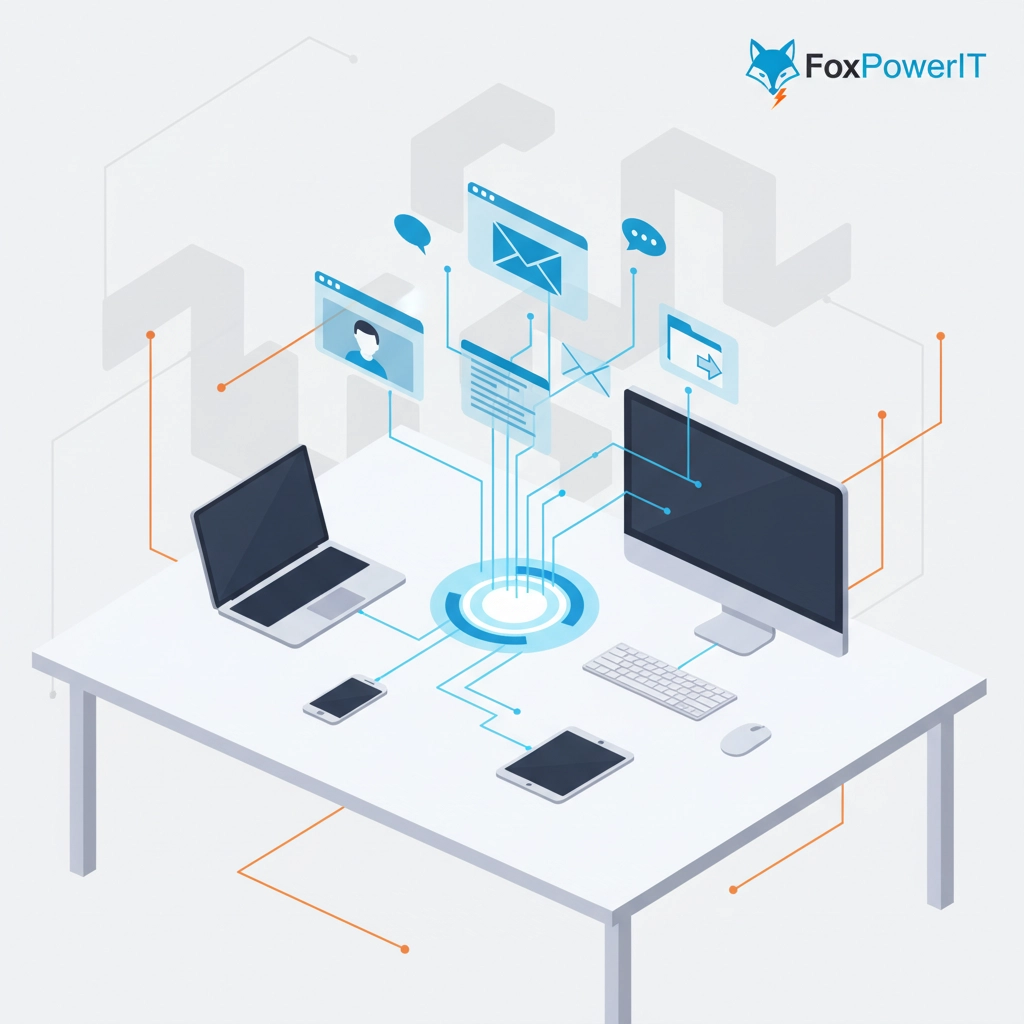Remember when "upgrading" your phone system meant swapping out a clunky desk phone for a slightly less clunky one? Those days are officially over. VoIP technology has evolved from a simple cost-cutting measure into an AI-powered communication powerhouse that's making traditional phone systems look like rotary phones at a smartphone convention.
Connecticut businesses are sitting at the epicenter of this transformation. While your competitors are still fumbling with outdated phone systems that can barely handle call forwarding, smart companies are leveraging VoIP features so advanced they border on science fiction. We're talking about systems that think, learn, and adapt: essentially giving your business a communication assistant that never sleeps, never takes sick days, and gets smarter every time someone picks up the phone.
Here are five game-changing VoIP features that are about to revolutionize how Connecticut businesses communicate in 2025.
1. AI-Powered Virtual Intelligence That Actually Gets Smarter
Your new VoIP system doesn't just answer calls: it understands them. AI-powered VoIP services now include speech recognition technology that can transcribe conversations in real-time, analyze customer sentiment, and even predict what callers need before they finish explaining their problem.

Here's what this looks like in practice: A customer calls your Hartford office complaining about a delayed shipment. Your AI system immediately recognizes the frustrated tone, pulls up the customer's order history, identifies the shipping delay, and routes the call to your best customer service rep: all before the second ring. Meanwhile, it's already preparing suggested solutions and flagging potential upselling opportunities based on the customer's purchase patterns.
The predictive analytics go even deeper. These systems learn your business patterns and can forecast call volume, identify peak hours, and automatically adjust staffing recommendations. One Connecticut manufacturing company saw their customer satisfaction scores jump 35% simply because their AI system started routing technical calls to engineers during high-stress periods and sales calls to their top performers.
Key AI Features That Matter:
- Real-time call transcription with searchable history
- Sentiment analysis that flags upset customers
- Automated responses for common inquiries
- Voice biometric security that prevents fraud
- Predictive routing based on caller history and agent expertise
2. 5G Integration: Crystal-Clear Communication at Lightning Speed
The widespread rollout of 5G networks across Connecticut has unlocked VoIP capabilities that seemed impossible just two years ago. We're talking about call quality so crisp it sounds like the person is sitting across from your desk, even when they're calling from their car in traffic on I-95.
5G-powered VoIP eliminates the frustrating delays and choppy audio that plagued earlier internet-based phone systems. Latency has dropped to virtually zero, meaning conversations flow naturally without the awkward pauses and "Can you hear me?" interruptions that killed momentum in important sales calls.
What 5G Integration Delivers:
- Ultra-low latency for seamless conversations
- Crystal-clear HD voice quality in any location
- Reliable video calls that don't freeze or pixelate
- Instant file sharing during calls without quality loss
- Mobile connectivity that rivals landline reliability
For Connecticut businesses with remote workers or field teams, this is a game-changer. Your sales rep calling from a client site in Stamford will sound just as clear as if they were calling from your main office in New Haven.
3. Unified Communication Hubs: One Platform to Rule Them All
Stop juggling five different communication apps. Modern VoIP systems have evolved into comprehensive unified communications platforms that consolidate voice calls, video conferences, instant messaging, email integration, and file sharing into a single, streamlined interface.

This isn't just about convenience: it's about eliminating the communication chaos that's costing your business money. How many times has an important decision been delayed because someone missed a Slack message, forgot to check their voicemail, and wasn't on the group email thread?
Unified communications solve this by creating a single source of truth for all business communications. Every conversation, whether it started as a phone call, video chat, or text message, gets logged in one central system where any team member can pick up where the last person left off.
Unified Communications Include:
- Voice calls, video conferences, and messaging in one app
- Shared calendars with automatic meeting scheduling
- File sharing with version control and access permissions
- Email integration that logs all customer communications
- Mobile apps that sync across all devices
- Presence indicators showing who's available, busy, or offline
4. Advanced Call Management with Intelligent Routing
Gone are the days of "press 1 for sales, press 2 for support" phone trees that make customers want to throw their phone out the window. Intelligent call routing uses AI to analyze incoming calls and automatically direct them to the right person based on the caller's history, the nature of their inquiry, and even the current workload of your team members.
Here's how smart routing works: When your biggest client calls, the system recognizes their number and immediately routes them to their dedicated account manager: or the next best option if that person is unavailable. If a new prospect calls asking about your services, the system can analyze their location, company size (pulled from publicly available data), and time of day to route them to the salesperson who's had the most success with similar leads.
Advanced Call Management Features:
- Intelligent routing based on caller ID and history
- Automatic queue management with estimated wait times
- Skills-based routing that matches calls to the right expertise
- Geographic routing for location-specific inquiries
- Time-based routing that adapts to business hours and holidays
- Overflow protection that redistributes calls during busy periods
The result? Customers get connected to the right person faster, your team stops playing phone tag, and important calls never fall through the cracks.
5. Cloud-Based Infrastructure with HD Voice Quality
Traditional phone systems required expensive hardware, dedicated phone lines, and IT staff to maintain servers that took up valuable office space. Cloud-based VoIP eliminates all of that overhead while delivering superior call quality through advanced HD voice codecs.

Cloud infrastructure means your phone system scales automatically as your business grows. Adding new employees is as simple as creating a new user account: no need to run new phone lines or buy additional hardware. The system handles automatic updates, security patches, and feature rollouts without any downtime or IT intervention.
HD voice quality uses advanced compression algorithms to deliver sound clarity that's noticeably better than traditional phone lines. This isn't just about sounding professional: clearer communication reduces misunderstandings, speeds up conversations, and reduces listener fatigue during long calls.
Cloud-Based Benefits:
- No expensive hardware or maintenance costs
- Automatic scaling as your team grows or shrinks
- Built-in redundancy and disaster recovery
- Regular feature updates with no downtime
- HD voice quality that surpasses landline clarity
- Integration with existing business software
- Advanced analytics and reporting dashboards
The Connecticut Advantage: Getting Ahead While Others Fall Behind
Connecticut businesses that embrace these advanced VoIP features now will have a significant competitive advantage over companies still relying on traditional phone systems. While competitors struggle with missed calls, poor audio quality, and communication silos, your business will operate with the efficiency and professionalism of a much larger organization.
The investment in modern VoIP technology pays for itself quickly. Companies typically see cost savings of 30-50% on their monthly communication bills, while productivity improvements from better call management and unified communications can add up to thousands of dollars in recovered time each month.
More importantly, these features position your business for the future. As AI and automation become standard in business operations, having a communication system that can integrate with and enhance these technologies will become essential for staying competitive.
Ready to Transform Your Business Communications?
The VoIP revolution is happening now, and Connecticut businesses that wait will find themselves scrambling to catch up. These five game-changing features aren't coming "someday": they're available today and already helping smart companies communicate more effectively, serve customers better, and operate more efficiently.
Don't let outdated communication technology hold your business back. Contact FoxPowerIT to learn how these advanced VoIP features can transform your Connecticut business communications and give you the competitive edge you need to thrive in 2025 and beyond.
The question isn't whether VoIP will become the standard for business communications: it's whether your business will be leading the pack or playing catch-up.

